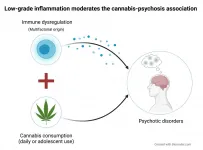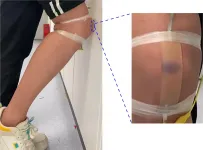Lies to hide doping in professional sport
Göttingen University sports sociologist analyses false statements from professional cyclists
2021-06-16
(Press-News.org) How do top athletes talk about doping when they themselves are using performance-enhancing drugs? Or do they just avoid the issue? A new study by the University of Göttingen reveals that any decision to use drugs almost inevitably means the decision to engage in deceptive communication such as lying or omitting information. Those using drugs, for example, regularly describe anti-doping policies as being more intense than ever or overly restrictive, play down the extent of the doping problem, or portray themselves as victims. The results were published in the European Journal for Sport and Society.
Dr Marcel Reinold, Head of Sport and Health Sociology at the Institute of Sport and Exercise Sciences at Göttingen University, analysed autobiographies of professional cyclists for the study. All of these autobiographies were written at a time before the cyclists were exposed as having used performance-enhancing drugs. The best-known examples are the two best-selling autobiographies by Lance Armstrong, former seven-time Tour de France winner, written in the early 2000s. In them, Armstrong portrays himself as "clean", although investigations by the US Anti-Doping Agency some ten years later revealed otherwise. "The main goal of this research is to identify the techniques of deceptive communication about doping - that is, typical communication strategies and statements that drug-users routinely employ to manipulate information and conceal doping," says Reinold.
Previous research on this subject has mainly emphasised that drug cheats adhere to a "law of silence". In effect, they usually simply ignore the subject of doping. This comparative analysis of the autobiographies shows, however, that prominent cyclists are under enormous social pressure to talk about the darker side of their sport in order to avoid suspicion of concealing drug use. Their writing, therefore, showed that they went beyond the relatively trivial technique of staying silent, instead using more complex techniques of deceptive communication. For instance, the doping control system is regularly described as more intense than ever before, as well as being overly restrictive. At the same time, they play down just how widespread doping can be. The clear intention is to suggest - despite evidence to the contrary - that in a "strictly controlled" and largely "drug-free" environment, there is simply no reason to use performance-enhancing drugs.
"The aim is clearly to convince the public that everything about the cyclist concerned is indeed honest and open," says Reinold. "These techniques help deceivers to present themselves as compliant with the anti-doping system and also to appear credible in their commitment against drugs. Furthermore, it helps to allay suspicion, prevent others discovering the lies and generally control the flow of incriminating information in such a way that prevents leaks or detection."
INFORMATION:
Original publication:, Marcel Reinold.Techniques of deceptive communication about doping. European Journal for Sport and Society (2021). Doi: https://doi.org/10.1080/16138171.2021.1930944
Contact:
Dr Marcel Reinold
University of Göttingen
Faculty of Social Sciences
Institute of Sport and Exercise Sciences
Sprangerweg 2, 37075 Göttingen, Germany
Tel: +49 (0)551-3925691
Email: marcel.reinold@uni-goettingen.de
[Attachments] See images for this press release:

ELSE PRESS RELEASES FROM THIS DATE:
2021-06-16
A new paper in the journal Cognition examines the visual complexity of written language and how that complexity has evolved.
Using computational techniques to analyze more than 47,000 different characters from 133 living and extinct scripts, co-authors Helena Miton of the Santa Fe Institute and Oliver Morin of the Max Planck Institute for the Science of Human History, addressed several questions around why and how the characters of different writing systems vary in how complex they appear.
"When we started this project, we wanted to test whether you find a general simplification of characters over time," Miton says. "Do scripts simplify their ...
2021-06-16
The presence of pro-inflammatory cytokines in the blood can boost the effects of daily cannabis use and heighten the risk of developing psychosis in adulthood. Similar results have been observed, also in the presence of cytokines, when cannabis is used during adolescence. Psychotic disorders have symptoms such as delirium, loss of a sense of reality, hallucinations, hearing voices, and cognitive and social impairments.
A study by researchers at the University of São Paulo's Ribeirão Preto Medical School (FMRP-USP) in Brazil, reported in an article in ...
2021-06-16
RUDN University biologist studied the aggressive impact of environmental factors (water, salts, and ozone) on ultrathin nanofibers of biopolymers. The results will help choosing suitable bioplastic depending on the use; for example, for medical implants, biodegradable packaging or filters for water cleaning. The results are published in the journal Polymers.
Bioplastics are an alternative to ordinary plastics. They are obtained from waste of plant and food industry. The safe composition allows using them as filters for gases and liquids, as "sponges" for cleaning reservoirs and medical implants. Depending on the field ...
2021-06-16
NEW YORK, NY (June 16, 2021)--Spectacular images of a molecule that shuttles omega-3 fatty acids into the brain may open a doorway for delivering neurological therapeutics to the brain.
"We've managed to obtain a three-dimensional structure of the transporter protein that provides a gateway for omega-3s to enter the brain. In this structure, we can see how omega-3s bind to the transporter. This information may allow for the design of drugs that mimic omega-3s to hijack this system and get into the brain," says first author Rosemary J. Cater, PhD, a Simons Society Fellow in the Mancia Lab at Columbia University Vagelos College of Physicians and Surgeons.
The study was published online on June 16 in the journal Nature.
A major challenge in treating ...
2021-06-16
Bay Area scientists have captured the real-time electrical activity of a beating heart, using a sheet of graphene to record an optical image -- almost like a video camera -- of the faint electric fields generated by the rhythmic firing of the heart's muscle cells.
The graphene camera represents a new type of sensor useful for studying cells and tissues that generate electrical voltages, including groups of neurons or cardiac muscle cells. To date, electrodes or chemical dyes have been used to measure electrical firing in these cells. But electrodes and dyes measure the voltage at one point only; a graphene sheet measures the voltage ...
2021-06-16
Should zoos display legally protected species that have been smuggled out of their range countries? A new study suggests that a pause and rethink may be needed, as it reports that accredited zoos have acquired a rare and legally protected reptile, the earless monitor lizard endemic to Borneo, without any evidence that the animals were legally exported.
The earless monitor lizard occurs only on the island of Borneo and has been described as a "miniature Godzilla" and "the Holy Grail of Herpetology." Discovered by western scientists almost 150 years ago, for most of this period the species was known largely from pickled specimens in natural history collections, and wasn't recorded from ...
2021-06-16
American Indian and Alaska Native Enrollment in Clinical Studies in the National Institutes of Health's Intramural Research Program
Dejonna Vigil, Ninet Sinaji, and Barbara Karp
This is the first study to provide data about the inclusion of American Indians and Alaska Natives in the National Institutes of Health's Intramural Research Program (NIH-IRP), which provides eligible individuals with access to innovative research treatments that may not otherwise be available. The program's mission is to include all Americans. This study analyzed data from more than 1,800 NIH-IRP protocols active in 2014 and 2017. While the number of American ...
2021-06-16
When someone bumps their elbow against a wall, they not only feel pain but also might experience bruising. Robots and prosthetic limbs don't have these warning signs, which could lead to further injury. Now, researchers reporting in ACS Applied Materials & Interfaces have developed an artificial skin that senses force through ionic signals and also changes color from yellow to a bruise-like purple, providing a visual cue that damage has occurred.
Scientists have developed many different types of electronic skins, or e-skins, that can sense stimuli through electron transmission. However, these electrical conductors are not always biocompatible, which could limit their use in some types of prosthetics. In contrast, ionic skins, or I-skins, ...
2021-06-16
Researchers at Karolinska Institutet in Sweden found industrial chemicals in the organs of fetuses conceived decades after many countries had banned the substances. In a study published in the journal Chemosphere, the researchers urge decision makers to consider the combined impact of the mix of chemicals that accumulate in people and nature.
"These are important findings that call for regulators to consider the collective impact of exposure to multiple chemicals rather than evaluating just one chemical at a time," says first author Richelle Duque Björvang, PhD student at the Department of Clinical ...
2021-06-16
As consumers and corporations alike become more environmentally conscious, the chemical industry is working to find solutions to the plastic waste crisis. One idea is to use biodegradable polymers known as polyhydroxyalkanoates (PHA) as replacements for traditional plastic packaging and other materials. A feature article in Chemical & Engineering News, the weekly newsmagazine of the American Chemical Society, explores the possibilities and pitfalls of PHA.
PHA is not a new human invention; this class of polymers can be found in nature and is used to store cellular energy, writes Senior Editor Alex Tullo. Commercially, it is manufactured through the industrial fermentation of sugars or lipids. As cities ...
LAST 30 PRESS RELEASES:
[Press-News.org] Lies to hide doping in professional sport
Göttingen University sports sociologist analyses false statements from professional cyclists




